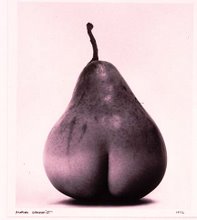In a recent web-surfing adventure, I found a hilarious site attempting to give a nice completely biased view of the history of homosexuality. Don't get me wrong, GLBT advocacy sites also worry me a bit in terms of their various interpretations of history, however focusonthefamily.org and it's various mirror site such as the one I'm about to introduce you to, are so very egregious in their interpretation of the facts as to make scholars everywhere spin their collective heads.
Here goes:
http://www.hyperhistory.net/apwh/essays/cot/t0w32homosexuality.htm
The text of the site appears here in red my response appears in italics.
Homosexuality was listed as a mental disorder by the American Psychiatric Association's Diagnostic and Statistical Manual until 1973 when sodomy advocates and lesbian organizations lobbied for de-listing. Report on other turning points towards the acceptance of homosexuality from ancient to modern times across cultures.
It is true that the APA amended the Diagnositic and Statistical Manual in 1973 removing homosexuality as a mental disorder. "Sodomy advocates" as Nosotro (the author) calls them is hardly an appropriate monkier for civil rights advocates. "Sodomy" after all has several meanings, "masturbation" among them.
It should also be noted that popular right-wing notion that the APA was just responding to partisan politics is, bluntly, wrong. The APA based its majority decision on a general trend occuring at the time, moving away from psycho-analysis's dominance. Not to mention that homosexuality's original inclusion in the DSM was value-laden, and didn't rest on evidence; try as the might, a link between psychopathy and homosexuality could not be established.
One must also make note that given the general attitude of the time, the APA was not bowing to pressure from "sodomy advocates", as the pressure to ignore the lack of evidence and uphold the status-quo was much greater then any "advocate" simply bringing the APA's attention to a flaw in scholarship.
Has homosexual behavior always been wrong or does it depend on culture, time, and place? Many people believe, under the banner of ‘tolerance’, that gays and lesbians should be allowed to marry with the same benefits, privileges, and acceptance that straight people receive. In the promotion of homosexuality, advocates imply that the life style has been accepted for centuries before the Puritans. How have homosexuals been accepted throughout history? Is today's Christian mainstream all so different from the stream of world history in the response to homosexuality? Why have past societies been uncomfortable with homosexuality?
One must immediately notice this article's thesis: has homosexuality always been wrong..? Biased and partisan "scholarship" does nothing to advance knowledge, it just reinforces notions of a specific society in a specific time period. In essence, it simply buttresses a position which can't be based purely on fact, most likely because said position is not actually supported by fact. A better thesis, and historical question would be: "How have same-sex interactions been viewed by cultures through the ages?" The last question that rounds out this paragraph is perhaps the most laughable. The author assumes that all past societies, including non-western cultures, have been "uncomfortable" with homosexuality. The author assumes, a very dangerous thing to do in historical research, that his own attitudes, and the societal norms which mold them are the same norms which dictated comfort-level in past societies, regardless of how they defined comfort, or their position on our modern conception of homosexuality.
Modern Jews are seen as accepting of homosexuality, however, their history and their laws, which are kept now only by the devout, show plainly that all historical Jewish cultures forbid homosexuality. During the Renaissance in Europe was when accepted homosexuality began to take root. More so in Italy, but nevertheless throughout the “enlightened” continent people began to preach homosexuality as just another thing that people sometimes do, like painting or traveling to England. This is also the period in which numerous and stringent laws began to be placed on “buggery”, “sodomy”, and other-worded things of that nature. From this point, the controversy over homosexuality ever so slowly gathered momentum until it became what it is today.
Here, the author blatantly states that reform and reconstructionists Jews are not devout (who as movements, have supported gay-rights), nor any jew that does not believe the author's interpretation of Judaism. This is perhaps on the verge of anti-semitism.
In stylistic terms, claiming the non-devoutness of jews as fact, without any support and ignoring context in history, is akin to holocaust denial. The same sort of methods are used. Many a synagogue-going-reform-Jew would vehemently deny any lack of religious devotion. Perhaps a better question the author should be concerning himself with is what has changed in Jewish thought? The author posits that the change in western (and Jewish) thought in regards to homosexuality all began with that insidious Renaissance. Let us remember that the Renaissance is a period when essentially medieval Europeans experienced a return to classicism in the arts, culture, and thinking. Yet, illogically, the author goes on later in his "article" to state that homosexuality was largely either absent or frowned upon by classical western cultures. Apparently, the critical thinker is left to believe that homosexuality's supposedly "warm reception" in the modern world began in the Renaissance, without any continuity of causes...it just "appeared".
The Egyptian Book of the Dead (Papyrus of Ani), in the Negative Confession, equates homosexuality with sin in a sort of Old Testament list of wrongs and sins that the speaker has not committed. A small portion of the list reads, “Hail, Qerrti, who comest forth from Amentet, I have not committed adultery, I have not lain with men. Hail, Her-f-ha-f, who comest forth from thy cavern, I have made none to weep.10” The Assyrian Laws of c. 1450-1250 B.C. contain the tidbit, “If a man has lain with his male friend and a charge is brought and proved against him, the same thing shall be done to him and he shall be made a eunuch.11”
In this paragraph, the author attempts to use the Papyrus of Ani as evidence that the ancient Egyptians despised homosexuality with the same amount of scorn the author does. Unfortunately for him, this certainly does not add up. The Papyrus of Ani is filled with hymns to Osiris, Isis and other deities, and with spells to assist the Necromancer and the deceased. The Papyrus of Ani, and other works like it, is a scroll which has been placed in a coffin or burial chamber; in other words, a book of the dead. Unlike the Bible, The Book of the Dead does not set forth religious tenets and was not considered by the ancient Egyptians to be the product of divine revelation, which allowed the content of the book of the dead to change over time. The things mentioned in the "Negative confession" portion of the Papyrus are not sins. In context of the Papyrus, the "Negative Confessions" portion is just where the deceased was to assert his innocence to the gods. It was the completion of this religious procedure that the Papyrus outlines that showed piety to the gods in Egyptian Religion, not that fact that the deceased was or was not honest when "confessing". Interestingly, when one actually reads the Papyrus, they read "..O He Who Sees What Has Been Brought, who comes forth from Panopolis,I have not ejaculated. " Obviously, given the importance of child-rearing in ancient Egypt, both the author and the deceased for whom this Papyrus was produced almost certainly ejaculated at some point. Even more interestingly, "..I have not lain with men" does NOT appear in any modern translation of the text. Apparently, the author must now invent information.
The author may actually seem to have a point in regards to assyrian law. However Assyrian law was largely an edition of Hammurabi's code, which said nothing pertaining to homosexuality. Additionally, the specific law the author does cite, is a law pertaining to RAPE. That is, it is listed under a section dealing conduct toward married women and rape. It must be remembered that in this part of the world in this time period, women were considered property. To rape another man was akin to making him property. However, sex with a temple-prostitute, male or female, was considered just being neighborly. The author, once again, takes facts out of historical context (this time, ancient near-eastern attitudes towards sex) and not only assumes (again) that they were similar to his own, but does it to push his own agenda. In other words, he's suppressing evidence.
Greece is the example many homosexuals turn to in their search for acceptance in ancient societies, yet their sources are vague, citing things like obscure vase art and a new interpretation of classic stories12.
This is perhaps the best example of what extremes the author will go too to prove his point, without getting into the messy business of actual scholarship. Archaeologists routinely draw information from "obscure" sources like vase art, along with every other physical artifact and remain left behind by cultures. Indeed, the actual written sources, by ancient Greeks themselves, mention what today we would term as "homosexual" (Read the works of Sappho), legitimate historians and anthropologists have written whole library sections on the subject. It is interesting however, how the author side-steps the entire issue of same-sex relations in the ancient Hellenistic world by branding every single primary source which indicates it as false. This is what is known as a "double standard fallacy" in which the author uses the a physical artifact such as the Papyrus of Ani to back up his claim (even though it doesn't) while dismissing the whole body of evidence from the greek-world.
Stick around for Part deux of "The religious-right hits a new low: History of the Homo", where we take a deep look at other claims of the author, and reasons as to what motivates his "research".
Tuesday, January 22, 2008
Subscribe to:
Comments (Atom)




